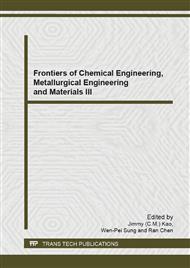p.16
p.20
p.25
p.33
p.38
p.43
p.47
p.51
p.57
Optimization of Lactose Content in the Row Milk by Colorimetry via Response Surface Methodology
Abstract:
The lactose content in the raw milk by colorimetry was introduced in the paper.On the single-factor experiment basis, it used response surface methodology to establish a quadratic mathematical model of lactose content. After analyzing the significance of the various factors and interactions, the results showed the optimum extraction conditions of detecting lactose content by colorimetry were as follows: reaction temperature 100°C, reaction time 5.2min, amount of precipitation 2.9 mL. In order to verify the method’s accuracy, five kinds of raw milk were chosen to test. The results showed the recoveries were between 97.122%-101.294%, so it is feasible to determine the content of lactose in raw milk.
Info:
Periodical:
Pages:
38-42
Citation:
Online since:
August 2014
Authors:
Price:
Сopyright:
© 2014 Trans Tech Publications Ltd. All Rights Reserved
Share:
Citation:


